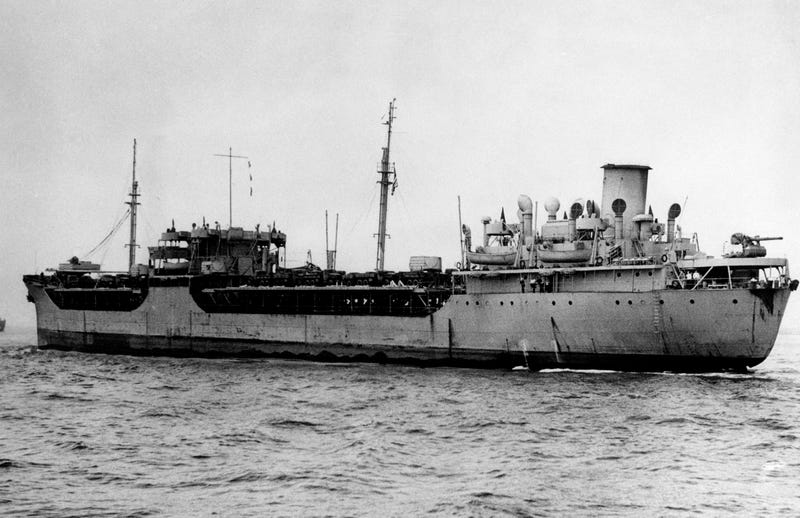
 Foxtrot AlphaTech and news from the world of modern defense.
Foxtrot AlphaTech and news from the world of modern defense.The sinking of the ammunition ship USS Serpens in January 1945 was the single deadliest day in the history of the Coast Guard. The gigantic explosion, which killed 250 sailors and almost vaporized the ship, was blamed on an accident involving the ship’s explosive cargo. Now, new allegations push the theory that the ship was actually attacked by a Japanese submarine—and that U.S. Navy officials were covering this up as late as 2003.
On the night of January 29th, 1945 the island of Guadalcanal was wracked by a truly massive explosion. The USS Serpens, whose crew had been handling a cargo of anti-submarine depth charges, exploded with the explosive force of 600 tons of explosives.
Serpens, a Liberty wartime transport ship 424 feet long and displacing 14,250 tons, practically disappeared in the blink of an eye. The ship, save for a section of the bow, disappeared from the face of the earth. Along with it went 193 Coast Guardsmen, 56 U.S. Army soldiers, and a U.S Public Health Service surgeon.
One sailor who responded to the explosion stated:
“…as we came into closer view of what had once been a ship, the water was filled only with floating debris, dead fish, torn life jackets, lumber and other unidentifiable objects. The smell of death, and fire, and gasoline, and oil was evident and nauseating. This was sudden death, and horror, unwanted and unasked for, but complete.”
Advertisement
The U.S. Navy would ultimately chalk up the incident to an accidental detonation of the ship’s cargo: 3,399 unfused bombs, each containing 350 pounds of high-explosive Torpex. That adds up to 1,189,650 pounds of high explosive, or 594 tons. As the Coast Guard states, “By 1949, the U.S. Navy officially closed the case deciding that the loss was not due to enemy action but an “accident intrinsic to the loading process.”

Advertisement
Now, 74 years later, a son of one of the lost crew members of the Serpens is lobbying for the Pentagon to reconsider the official explanation. Backing him up are some curious facts, allegations, and discrepancies, as reported recently by the The Sarasota Herald-Tribune. Here are some highlights from that story:
- Amazingly, there were two survivors of the ship explosion, both of whom survived in the remaining bow section of the ship. One of them reported that a Japanese submarine had been tracking the Serpens before the explosion.
- Two explosions were heard by nearby military personnel. The second explosion was the detonation of the million plus pounds of high explosives aboard the ship. According to the submarine theory, the first explosion was a torpedo which then set off a huge “secondary” explosion of the ship’s cargo.
- A majority of the Court of Inquiry convened to look into the accident believed that the ship had been the victim of enemy action—yet the Navy still insisted the cause of the explosion had been an accident.
- Japanese radio propaganda actually announced the explosion before Japan could have plausibly learned about it from the Americans, suggesting a submarine reported the attack back to Tokyo.
- Veering into sinister territory: the Navy Judge Advocate General’s conclusions on the Serpens’ sinking, dated 1949, “were checked out of the National Archives Records Administration in 2003 by the Navy JAG’s office and never returned.”
Advertisement
And as that story notes, the man who’s been pushing for this—the son of a Coast Guardsman who died about the Serpens—isn’t just some guy. Here’s his background:
After pressing Florida politicians and pursuing government records with Freedom of Information Act requests, Robert Breen of Venice has discovered curious gaps in the Serpens’ obituary.
And at 76, the retired Central Intelligence Agency senior finance officer and certified fraud investigator wonders if he’s onto one of the last coverups of World War II.
Advertisement
So why would the U.S. Navy cover up the incident? By 1945 Guadalcanal was thousands of miles behind friendly lines and was part of the logistics chain supporting the Allies’ advance on Japan itself. Anti-torpedo nets were supposed to be strung along Lunga Point to protect ships like the Serpens, but were often less than 100 percent reliable.
The death of 250 military personnel far from the front line would have been a major embarrassment to the Navy.
Advertisement

Could the Navy reverse course and come clean? In 2001, Naval historians pieced together enough evidence to convince the Chief of Naval Operations and Secretary of the Navy that the USS Eagle 2, a patrol boat sunk off the coast of Maine in 1945, was the victim of a submarine attack. For decades, the Navy believed Eagle-2 had been the victim of a boiler explosion.
Advertisement
Historians discovered reports by survivors that a mysterious submarine with unique symbols painted on the conning tower was sighted at the time of the attack. The symbols matched those painted on the German Navy U-boat U-583, proving it was responsible for the sinking.
The official explanation for the loss of Serpens leaves open the possibility that members of the crew were in some way incompetent and caused their own deaths. A submarine attack, on the other hand, could mean that local anti-submarine defenses were not strong enough and would fault the Navy’s leadership.
Advertisement
Reopening the case of the Serpens could help clear the names of the crew—and determine why the real truth didn’t come out decades sooner.













